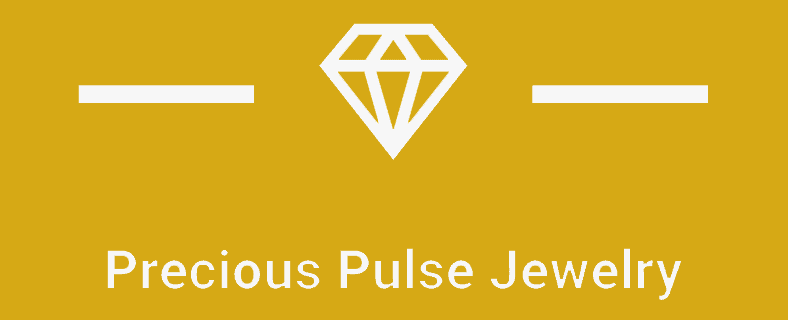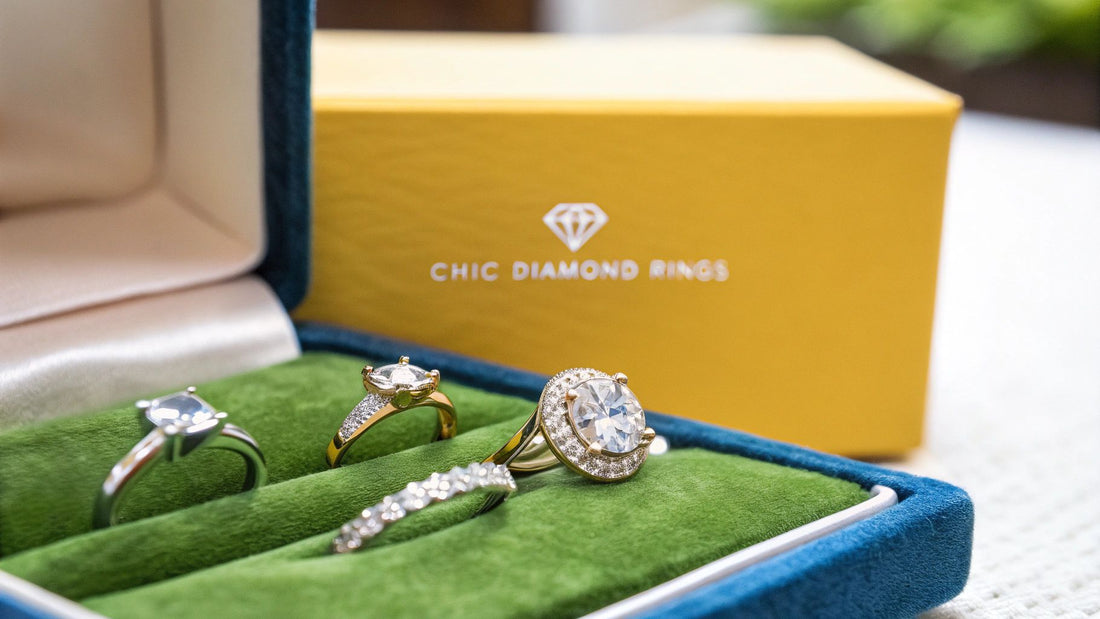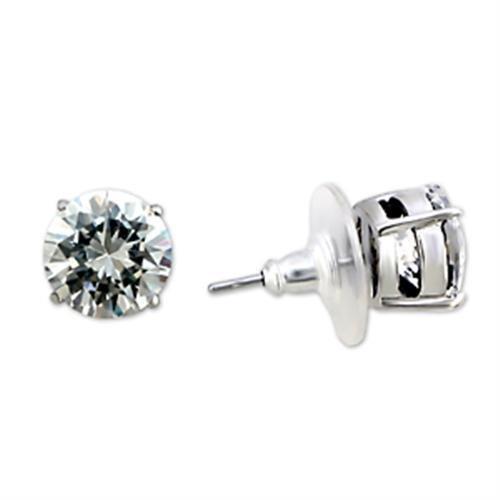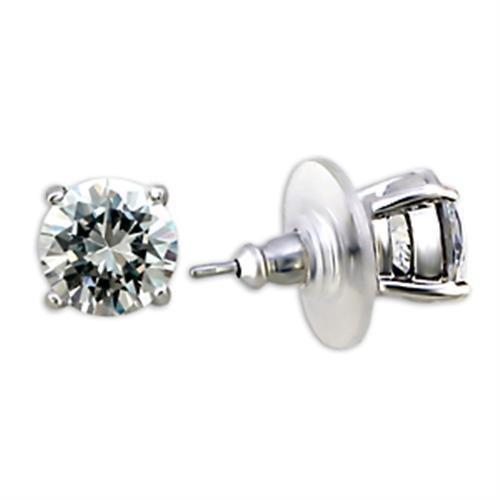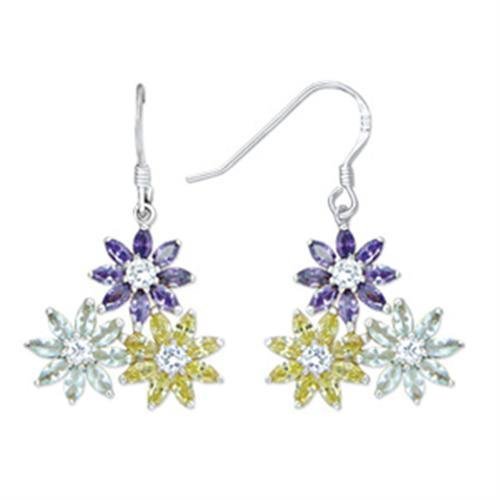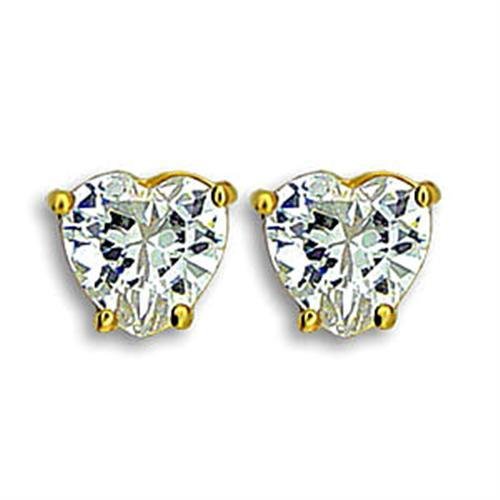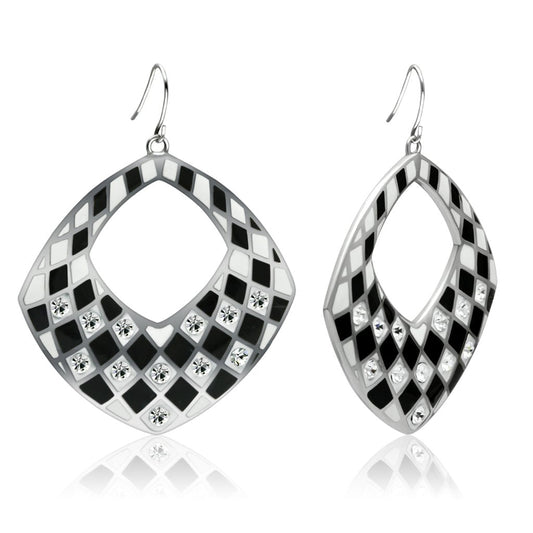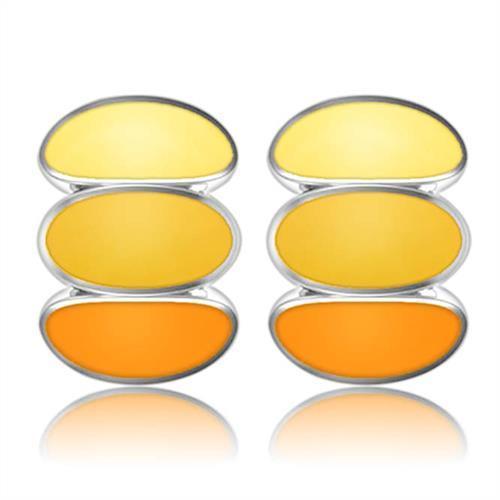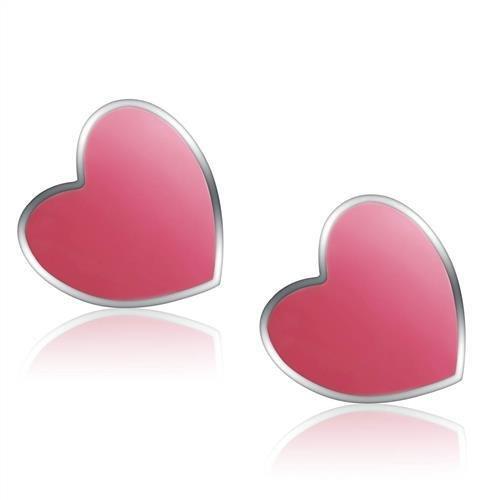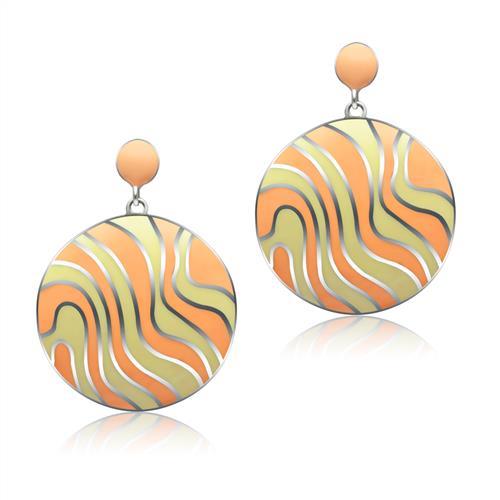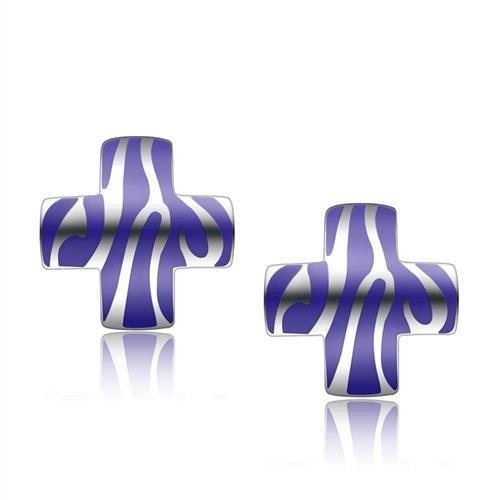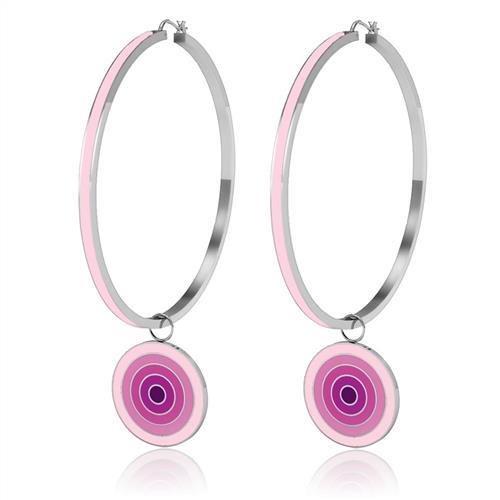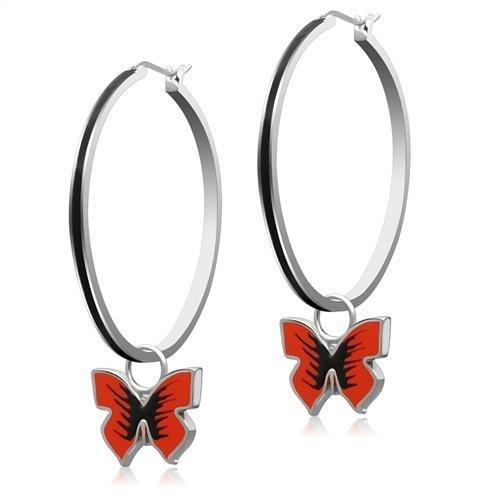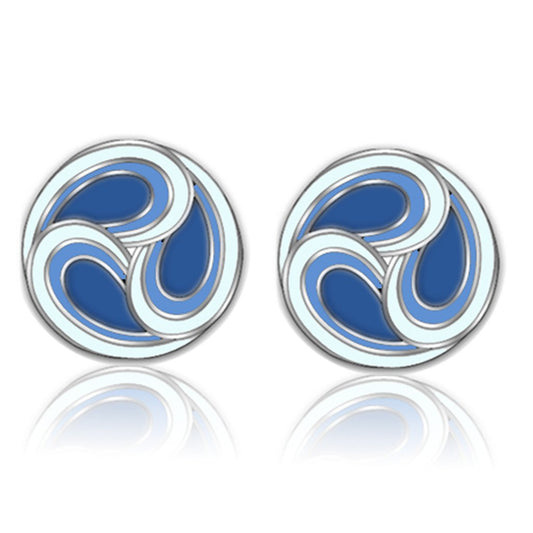When you hear "diamond ring," your mind probably jumps straight to "engagement." While they're the classic symbol of a proposal, a whole world of stunning diamond rings that are not engagement rings exists, each serving a different—but equally meaningful—purpose. These pieces are for celebrating personal wins, marking relationship milestones, or just making a fabulous fashion statement. This guide will walk you through the most popular styles, help you choose the right one, and give you practical tips on how to wear and care for your new favorite accessory.
Beyond The Proposal: Why Diamonds Are For Everyone
For centuries, diamonds have been linked to love and commitment, a tradition that really took off back in 1477 when Archduke Maximilian of Austria proposed with one. But the idea that a diamond only means marriage? That’s a much more modern concept, heavily shaped by marketing campaigns in the 20th century.
Today, that story is changing. More and more, people are buying diamond jewelry for themselves to honor a personal victory or simply because they fell in love with a design. A diamond ring can be as versatile as a little black dress—perfect for any occasion and a timeless piece for any collection. Think of it less as a promise to someone else and more as a celebration of your own journey. This shift empowers everyone to enjoy the sparkle of diamonds without waiting for a specific event.
Categories of Diamond Rings
This infographic breaks down the main categories of diamond rings that go beyond the traditional engagement piece.
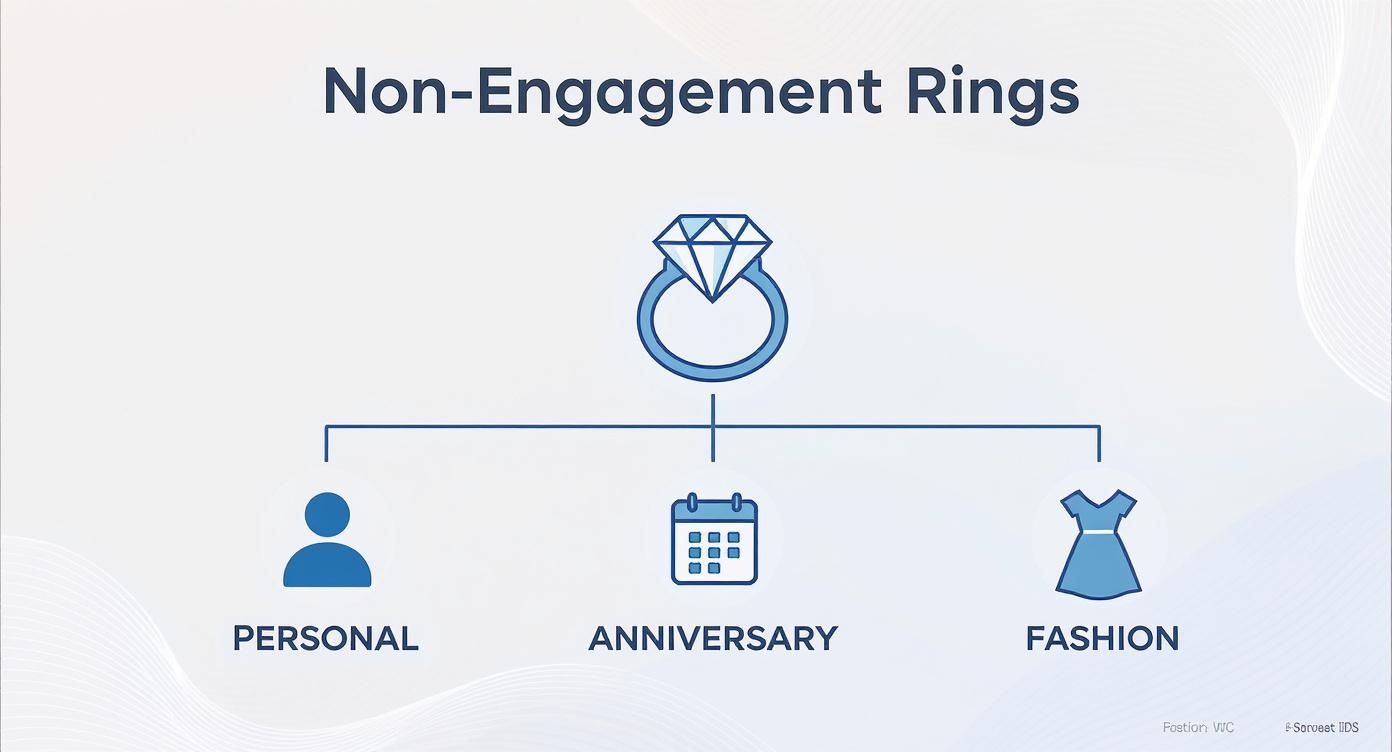
As you can see, these rings generally fall into three core categories: personal, anniversary, and fashion. Each one carries its own unique style and significance. Getting to know these distinctions is the first step toward finding a piece that truly speaks to you or a loved one.
To help you navigate this sparkling world, here’s a quick-glance table that breaks down the most common types of non-engagement diamond rings.
Quick Guide to Diamond Ring Categories
| Ring Type | Occasion or Purpose | Style Highlights |
|---|---|---|
| Anniversary/Eternity Band | Marking milestones in a long-term relationship. | A continuous line of diamonds, symbolizing endless love. |
| Right-Hand/Cocktail Ring | A statement of personal style or independence. | Bold, dramatic, and often features a large center stone. |
| Promise Ring | A pre-engagement symbol of commitment. | Daintier and more understated than an engagement ring. |
| Stackable Ring | Building a personalized, evolving collection over time. | Slim bands, often with micro-pavé diamonds or mixed metals. |
| Fashion Ring | Worn simply for style and personal expression. | Can be anything from minimalist bands to elaborate designs. |
This table is just the starting point. Now, let’s dive deeper into what makes each of these ring types so special.
Throughout this guide, we'll explore each of these categories, from elegant anniversary bands that honor a shared history to bold cocktail rings that express individual flair.
A diamond ring doesn't have to be a question. It can be an exclamation point—a bold declaration of self-love, a marker of a significant life event, or a simple celebration of personal style.
We will cover the unique characteristics of several key types, including:
- Anniversary Bands and Eternity Rings: Timeless symbols of enduring love and commitment shared between partners over the years.
- Right-Hand and Cocktail Rings: Worn to showcase personal style, independence, and accomplishments.
- Stackable Rings: Versatile pieces that allow you to build a personalized, ever-evolving collection.
By the end, you'll see diamond rings not just as symbols of engagement, but as powerful emblems of life's many celebrated moments.
Choosing Anniversary And Eternity Bands
While an engagement ring marks a beautiful promise, anniversary and eternity bands celebrate the journey that's already unfolded. They're a testament to shared history and continued commitment, making them one of the most popular types of diamond rings that are not engagement rings.
These rings are perfect for marking any milestone, from your first year together to your fiftieth. They don't signify a beginning—they honor the love that keeps growing stronger every day.
When you start looking, you'll quickly discover the two main styles: the full-eternity band and the half-eternity band. A full-eternity ring is pure, uninterrupted sparkle, with diamonds wrapping all the way around to symbolize endless love. The half-eternity style, with diamonds just across the top, offers a more practical (and often more affordable) alternative.
Choosing between them often comes down to your lifestyle. That stunning, all-around sparkle of a full-eternity ring is breathtaking, but it can be difficult—or even impossible—to resize. The diamonds on the underside can also feel a bit rough against your skin during daily tasks.
Full Versus Half Eternity: A Closer Look
Which style is right for you? It’s like choosing between a gorgeous formal gown and a versatile cocktail dress. Both are stunning, but one is much better suited for everyday life. Here’s a practical breakdown to help you decide.
- Comfort: The smooth metal bottom of a half-eternity band is simply more comfortable for things like typing, gripping a steering wheel, or holding hands.
- Resizing: Life happens, and finger sizes can change. The plain metal shank on a half-eternity band makes resizing a breeze, while full-eternity rings are generally a final-sale kind of fit.
- Durability: The diamonds on the palm-side of a full-eternity ring are exposed to every knock and scrape. This means more potential for maintenance down the road.
- Budget: With fewer diamonds, half-eternity bands are friendlier on the wallet. This often lets you put that extra budget toward higher-quality stones for the part of the ring everyone sees. If you're exploring budget-friendly options, our guide on CZ eternity bands is a great place to start.
Pairing Your New Band
Adding an anniversary band to your existing stack is an art. The goal is harmony, not competition. It should feel like the perfect accessory that completes your favorite outfit—it enhances, it doesn't clash.
Start by looking at the metal and setting of your current rings. A platinum anniversary band will slide right in with a platinum engagement ring, creating a seamless, unified look. But don't be afraid to mix things up! Adding a yellow gold band to a white gold set can create a really stylish and modern stack.
The diamond setting is just as important. If your engagement ring has a pavé band, a matching pavé anniversary band will look like they were made for each other, creating an incredible wall of sparkle.
The growing popularity of non-engagement diamond jewelry is a significant driver in the market. It reflects a broader trend of celebrating various life milestones with enduring symbols of affection and personal achievement.
This isn't just a feeling; the numbers back it up. The overall diamond jewelry market was valued at USD 389.5 billion in 2025 and is projected to hit USD 622.5 billion by 2035. This incredible growth is fueled by rising disposable incomes and a cultural shift where beautiful diamond jewelry is for celebrating all of life's moments, not just a proposal. You can explore more insights on the diamond jewelry market on futuremarketinsights.com.
The Right-Hand Diamond Statement
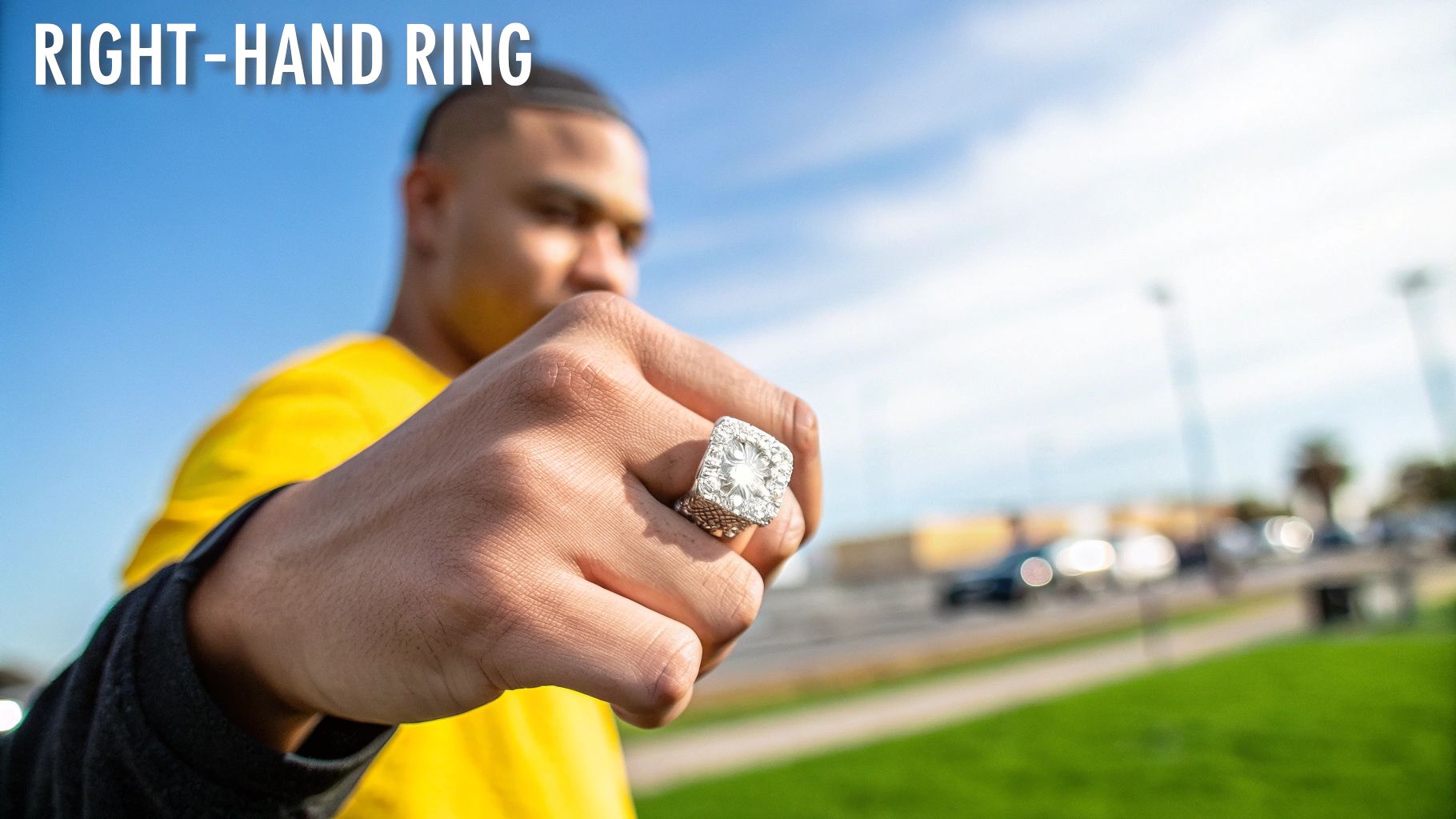
While tradition reserves the left hand for symbols of partnership, your right hand is your personal canvas. This is where a diamond ring becomes a powerful emblem of your independence, your accomplishments, and your unique style. It's a piece you buy for yourself, by yourself, to celebrate who you are right now.
Think of a right-hand ring as the signature piece in your jewelry collection. It’s purely about self-expression, making it one of the most exciting categories of diamond rings that are not engagement rings. It can be as bold, as understated, or as brilliant as you want it to be.
This isn't just a niche trend; it's part of a much larger shift in how we buy luxury. The global diamond ring market was valued at around USD 78 billion in 2023 and is on track to hit USD 112 billion by 2032. That growth isn't just about proposals—it’s driven by people celebrating personal milestones with jewelry that tells their own story. You can learn more about the growth of the diamond ring market at dataintelo.com.
Cocktail Pieces Versus Everyday Fashion
The world of right-hand rings splits beautifully into two main styles: the dramatic cocktail ring and the chic everyday fashion ring. Choosing between them is all about the kind of statement you want to make and where you plan to wear it.
A cocktail ring is designed to be noticed. It’s the life of the party, featuring large, eye-catching gems, intricate settings, and an unapologetically bold design. This is the perfect accessory for special occasions where you want your jewelry to do all the talking.
On the other hand, an everyday fashion ring is more subtle but equally stylish. It's your go-to piece for adding a touch of sparkle to daily life, from the office to a casual brunch. These designs are usually sleeker, lower-profile, and built for comfort and versatility. Many of the beautiful rings in our collection are designed to be worn every day, offering that perfect touch of affordable luxury.
Styling Your Statement Piece
The secret to a polished look is balance. You want your right-hand ring to be the star of the show, not just another voice in a cluttered ensemble.
Your right-hand ring isn't just an accessory; it's a declaration. It says, "I bought this for me, because I love it," and that's the most powerful statement of all.
Follow these simple tips to let your ring shine:
- Keep Other Jewelry Minimal: If you're wearing a bold cocktail ring, pair it with delicate bracelets or a simple necklace. Let the ring be the undisputed focal point.
- Balance Your Hands: Avoid wearing chunky bracelets on the same wrist as your statement ring. Instead, wear them on the opposite arm to create a sense of harmony and balance.
- Mix Metals Thoughtfully: Don't be afraid to mix gold, silver, and rose gold—just do it with intention. A simple rule of thumb is to have at least one other piece that matches the metal of your statement ring to tie the whole look together.
Ultimately, the best right-hand ring is the one that feels like you. Whether you choose a dramatic, colorful cocktail piece or a sleek, modern band, wear it with the confidence that comes from celebrating yourself.
Building Your Stackable Diamond Ring Collection
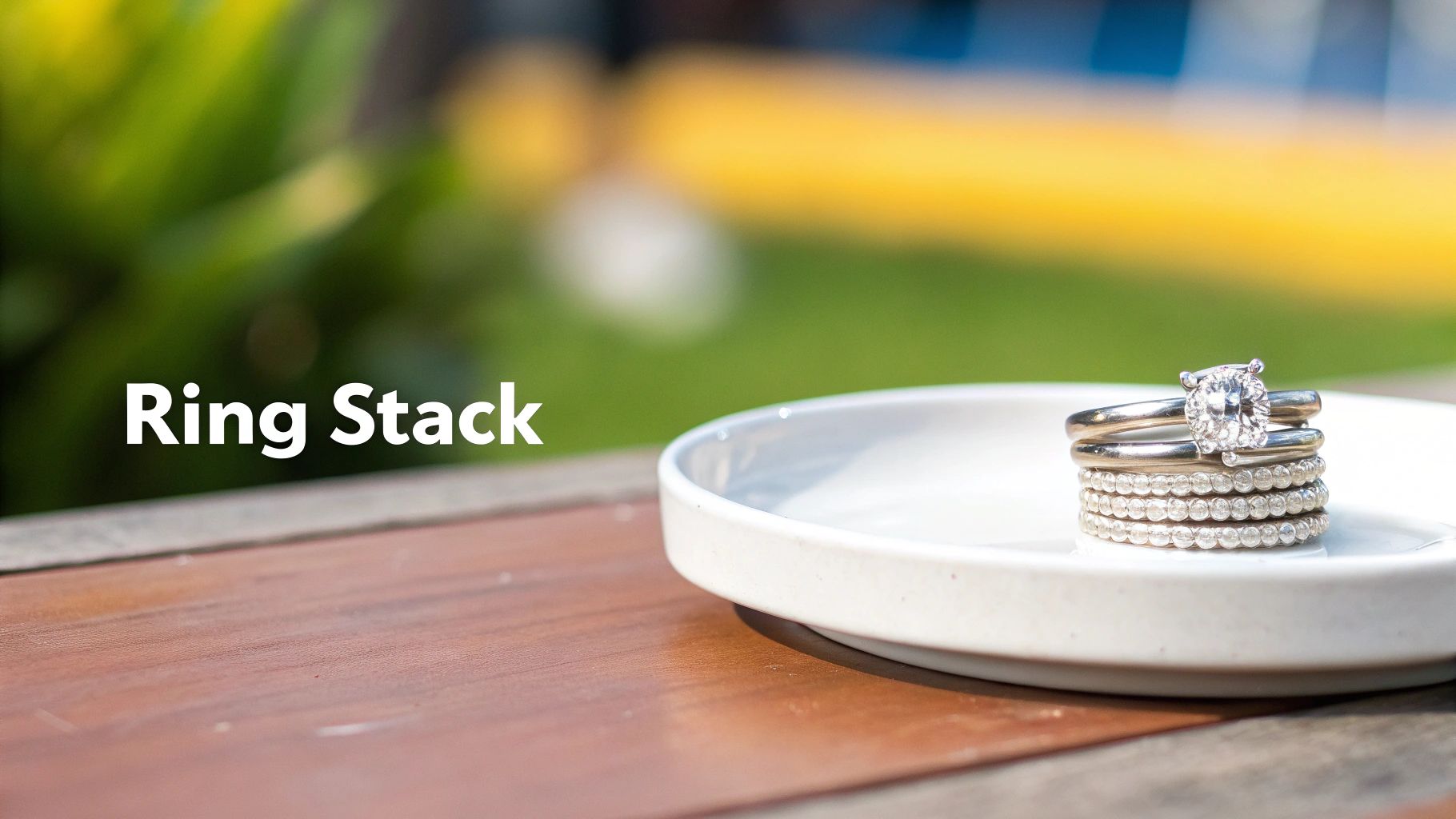
Stackable rings are more than just a trend; they're a way to turn your fingers into a living storyboard. Each new band you add marks a memory, a milestone, or just a new chapter in your style evolution.
Building a personal stack is a creative outlet, allowing you to curate a collection of diamond rings that are not engagement rings. It’s about expressing your journey, one shimmering layer at a time. Think of it like a chef pairing flavors—the goal is to create something beautifully harmonious or strikingly complementary. Each ring adds a new note, letting you compose a look that is entirely your own. It's less about rules and more about trusting your instincts.
Starting Your Stack The Right Way
Every great collection begins with a solid foundation. Your first piece, or "base band," should be something you absolutely love wearing on its own. This could be a simple, classic gold band or perhaps a delicate diamond eternity ring. It’s your anchor.
Once you have your base, the real fun begins: layering in more expressive pieces. The key is to introduce contrast, but in a thoughtful way.
- Varying Textures: Try pairing a smooth, polished band with something textured, like a milgrain or hammered finish. The contrast adds a wonderful visual depth.
- Mixing Shapes: Layer a band with classic round diamonds next to one featuring baguettes or marquise-cut stones. This creates a far more dynamic and interesting look.
- Playing with Metals: Don't be shy about mixing yellow, white, and rose gold. A tri-color stack can look incredibly chic and modern.
Building a stack is your personal design lab. Each ring is an experiment in style, allowing you to tell a story that is uniquely yours without saying a word.
The most meaningful collections grow organically over time. There's no need to rush out and buy five rings at once. Instead, let each new piece mark a special moment—a birthday, a promotion, or even just a Tuesday when you felt like treating yourself. This slow, steady approach ensures your stack is not only beautiful but also deeply personal.
Sample Stacks For Inspiration
To get your creativity flowing, here are a couple of popular stacking styles to consider. As you build your collection, you might find that our guide on the best rings for stacking gives you even more ideas to craft the perfect combination.
- The Minimalist: Start with a thin, plain metal band. Next, add a delicate micro-pavé diamond band. The result is a touch of sparkle that feels elegant and wonderfully understated.
- The Maximalist: Begin with a bold channel-set diamond band. From there, layer on a vintage-inspired floral ring and top it all off with a colorful gemstone band for a vibrant, eye-catching statement.
By mixing widths, metals, and diamond shapes, your stack truly becomes a reflection of you.
Navigating Diamond Options For Non-Engagement Rings
Choosing the right diamond for a non-engagement ring doesn't have to feel like studying for a geology exam. While the technical details can go deep, all you really need are a few key pointers to find a stone that fits your style and budget perfectly. It’s less about memorizing jargon and more about knowing what truly matters for the specific ring you have in mind.
You’ve probably heard of the famous 4Cs—Cut, Color, Clarity, and Carat. Think of them as a diamond's core personality traits. For certain rings, some of these traits are front and center, while others can take a backseat.
Take an eternity band, for example, where dozens of tiny stones sit side-by-side. Here, consistent color and good clarity are everything for a seamless, brilliant sparkle. But for a dramatic, vintage-inspired cocktail ring, you might actually prefer a warmer color to give it more character and soul.
Prioritizing The 4Cs For Your Ring
How you weigh the 4Cs is completely dictated by the ring’s design and purpose. This practical approach helps you get the most sparkle for your budget. Here's a simple guide to what matters most for each style.
- For Cocktail Rings: A dazzling cut is non-negotiable. You want a stone engineered to maximize sparkle and catch eyes from across the room. Color and clarity can be more forgiving, allowing you to get a larger carat size for your money.
- For Eternity Bands: Clarity and color consistency are critical. Because the stones are set so close together, any small imperfection or color mismatch will stand out. The cut is also important for overall brilliance.
- For Stackable Rings: Carat weight can be smaller and more delicate. This allows you to mix and match different bands without overwhelming your finger. Focus on a good cut to ensure even small stones sparkle brightly.
Natural Diamonds Versus Lab-Grown Diamonds
Today’s market gives you a fantastic choice between natural, earth-mined diamonds and their lab-grown counterparts. This isn't about one being "better" than the other; it’s about what aligns with your values and budget. It’s like picking between two incredible vacation spots—both offer a beautiful experience, but the journey and the cost are different.
The rise of lab-grown diamonds is making a huge impact on the market, especially for diamond rings that are not engagement rings. These stones, often praised as a more sustainable and cost-effective option, are surging in popularity. This shift is fueled by growing consumer awareness and a move toward more conscious purchasing, which is reshaping the entire jewelry industry. You can read more about how the diamond industry is adapting on rapaport.com.
Before we go further, let's quickly break down the key differences in a simple table.
Natural vs. Lab-Grown Diamonds: A Quick Comparison
| Feature | Natural Diamonds | Lab-Grown Diamonds |
|---|---|---|
| Origin | Formed over billions of years deep within the Earth's mantle and mined. | Created in a controlled laboratory environment in a matter of weeks. |
| Chemical & Physical Properties | Identical to lab-grown diamonds. Both are pure carbon. | Identical to natural diamonds. They are real diamonds in every sense. |
| Cost | Generally more expensive due to rarity and mining costs. | Typically 20-40% less expensive than natural diamonds of similar quality. |
| Resale Value | Tend to retain value better over the long term. | Resale market is still developing and value retention is lower. |
| Ethical & Environmental Impact | Can be associated with environmental disruption and ethical concerns ("conflict diamonds"). | Often seen as a more sustainable choice with a smaller carbon footprint. |
Ultimately, both paths lead to a stunning, real diamond. The choice is yours.
Choosing between natural and lab-grown diamonds is a personal decision. Both are chemically and visually identical; the only difference is their origin story.
Knowing your options puts you in the driver’s seat. Whether you're captivated by the timeless story of a natural diamond or drawn to the modern innovation of a lab-grown one, you can make a choice that feels right for you. To go a bit deeper, check out our guide on what are lab-grown diamonds.
How to Care For Your Diamond Rings and Keep Them Sparkling
A diamond's job is to sparkle, but it needs a little help from you to stay brilliant. Just like a cherished car needs a wash, your diamond rings that are not engagement rings need regular attention to look their best. Everyday life—lotions, soaps, even the natural oils from your skin—can build up a film that dulls your diamond's fire.
The good news? Keeping them clean is surprisingly simple. You don't need fancy chemicals or expensive kits for a quick refresh.
Your Go-To At-Home Cleaning Ritual
A gentle at-home bath is usually all it takes to bring back that "just out of the box" gleam. All you need is a bowl of warm water and a few drops of a mild dish soap. That simple mix is powerful enough to cut through grime without being harsh on your precious metals or stones.
Here’s the four-step process to restore your ring's shine:
- Soak: Let your ring sit in the soapy water for about 20-40 minutes. This gives the solution time to work its magic and loosen any buildup.
- Brush: Grab a very soft-bristled toothbrush (a baby toothbrush is perfect for this) and gently scrub the diamond. Pay special attention to the setting, especially underneath the stone—that’s where dirt loves to hide.
- Rinse: Hold the ring under warm running water. A quick rinse will wash away the soap and all the grime you just dislodged. Just be sure to plug the sink drain first! We've all heard the horror stories.
- Dry: Pat the ring dry with a soft, lint-free cloth. Steer clear of paper towels; they can leave behind tiny fibers or, worse, put fine scratches on softer metals.
Why You Still Need a Professional Jeweler
While home cleanings are great for daily maintenance, think of a professional jeweler as the deep-clean spa day for your ring. You should aim for a visit at least once a year. It’s the best wellness check-up your jewelry can get.
A jeweler uses specialized equipment like ultrasonic cleaners and steamers to safely remove deep-set grime. More importantly, they’ll inspect the prongs and setting for any signs of weakness or damage. Catching a loose prong early can mean the difference between a simple repair and a lost diamond. It’s a small investment in maintenance that protects a much, much larger one.
Proper storage is just as crucial as cleaning. A dedicated, safe space protects your rings from the elements and from each other, ensuring they stay pristine for years to come.
Think of it this way: you wouldn't toss a fine silk scarf in a drawer with zippers and keys, would you? The same logic applies here. Storing your diamond rings separately prevents them from scratching other jewelry. A fabric-lined box with individual compartments or a soft pouch for each ring is ideal. Remember, diamonds are incredibly hard and can easily scratch other gemstones and even gold or platinum.
Finally, a few good habits go a long way. Make it a rule to take your rings off before you work out, do any gardening, or handle harsh cleaning chemicals. This simple checklist of do’s and don’ts will ensure your beautiful diamond rings that are not engagement rings shine on for a lifetime.
Common Questions About Non-Engagement Diamond Rings
Jewelry etiquette often seems daunting. But with diamond rings that are not engagement rings, you have much more freedom. Let’s tackle the most frequent questions so you can choose and wear your ring confidently.
Is there a ‘correct’ finger for a non-engagement ring?
Absolutely not. While the left ring finger is traditionally reserved for wedding and engagement rings in many cultures, you have ten fingers to play with. Many people choose the right-hand ring finger for a statement piece, but your middle finger, index finger, or even thumb are all fantastic options for showcasing your style. The choice is entirely up to you and what feels most comfortable and expressive.
Can you resize any diamond ring?
It depends entirely on the ring's design. A ring with a plain metal shank (the bottom part of the band) is typically easy for a jeweler to resize up or down. However, full eternity bands, where diamonds circle the entire ring, are often impossible to resize without compromising the structure and setting. It's crucial to get your size exactly right before purchasing a full eternity style. Half-eternity and other designs are much more flexible.
How Can You Tell It’s Not An Engagement Ring?
While there's no official rulebook, some design cues can help differentiate them. Engagement rings often feature a prominent center diamond, like a classic solitaire. Non-engagement rings tend to be more varied and expressive in their design.
- Cocktail Rings: These are usually unmistakable with their large, often colorful gems and bold, intricate settings. They're designed to be conversation starters.
- Eternity Bands: A continuous or half-band of same-sized diamonds typically signifies an anniversary or milestone, not a proposal.
- Stackable Rings: These are slim, delicate bands designed to be worn in multiples. A single one is understated, while a stack tells a more complex style story.
- Unique Designs: Rings with unconventional shapes, asymmetrical diamond placements, or mixed metals often fall into the fashion or self-purchase category.
The beauty of a non-engagement ring lies in its freedom. It doesn’t need to follow a script or tradition; its only job is to reflect your personal style and story.
Budgeting And Mixing Your Pieces
Forget outdated rules like the "three months' salary" guideline—that was a marketing tactic for engagement rings. For a non-engagement diamond ring, the budget is entirely personal. It should be an amount that feels comfortable for you, whether it's an affordable treat or a significant investment in a milestone piece.
When mixing diamonds into your everyday jewelry, balance is key.
- Lead with one bold ring and keep jewelry on other fingers more minimal to let it stand out.
- Create a cohesive look by matching metals, or create an intentionally eclectic vibe by mixing them thoughtfully.
- Play with shapes and textures. Combine a smooth band with a pavé band, or pair a ring with round diamonds next to one with baguettes.
Ready to find your perfect diamond ring? At Precious Pulse Jewelry, we believe every piece reflects who you are.
Explore our stunning and affordable collection to find the ideal diamond ring for any moment—or no moment at all. Discover your next favorite piece at https://preciouspulsejewelry.com.
